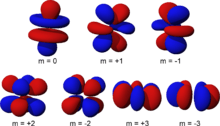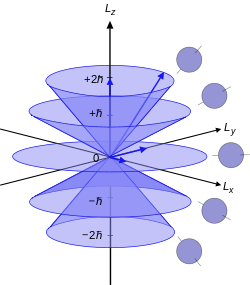Magnetic quantum number
In atomic physics, the magnetic quantum number, designated by the letter ml, is the third in a set of four quantum numbers (the principal quantum number, the azimuthal quantum number, the magnetic quantum number, and the spin quantum number) which describe the unique quantum state of an electron. The magnetic quantum number distinguishes the orbitals available within a subshell, and is used to calculate the azimuthal component of the orientation of orbital in space. Electrons in a particular subshell (such as s, p, d, or f) are defined by values of ℓ (0, 1, 2, or 3). The value of m can range from -ℓ to +ℓ, inclusive of zero. Thus the s, p, d, and f subshells contain 1, 3, 5, and 7 orbitals each, with values of m within the ranges ±0, ±1, ±2, ±3 respectively. Each of these orbitals can accommodate up to two electrons (with opposite spins), forming the basis of the periodic table.
Derivation

There is a set of quantum numbers associated with the energy states of the atom. The four quantum numbers , , , and specify the complete and unique quantum state of a single electron in an atom called its wavefunction or orbital. The Schroedinger equation for the wavefunction of an atom with one electron is a separable partial differential equation. (This is not the case for the helium atom or other atoms with mutually interacting electrons, which require more sophisticated methods for solution[1]) This means that the wavefunction as expressed in spherical coordinates can be broken down into the product of three functions of the radius, colatitude (or polar) angle, and azimuth:[2]
The differential equation for can be solved in the form . Because values of the azimuth angle differing by 2 (360 degrees in radians) represent the same position in space, and the overall magnitude of does not grow with arbitrarily large as it would for a real exponent, the coefficient must be quantized to integer multiples of , producing an imaginary exponent: .[3] These integers are the magnetic quantum numbers. The same constant appears in the colatitude equation, where larger values of 2 tend to decrease the magnitude of , and values of greater than the azimuthal quantum number do not permit any solution for .
| Relationship between Quantum Numbers | |||
|---|---|---|---|
| Orbital | Values | Number of Values for [4] | Electrons per subshell |
| s | 1 | 2 | |
| p | 3 | 6 | |
| d | 5 | 10 | |
| f | 7 | 14 | |
| g | 9 | 18 | |
As a component of angular momentum

The axis used for the polar coordinates in this analysis is chosen arbitrarily. The quantum number m refers to the projection of the angular momentum in this arbitrarily chosen direction, conventionally called the z direction or quantization axis. Lz, the magnitude of the angular momentum in the z direction, is given by the formula:[4]
This is a component of the atomic electron's total angular momentum, , whose magnitude is related to the azimuthal quantum number of its subshell by the equation:
where is the reduced Planck constant. Note this for and approximates for high . It is not possible to measure the angular momentum of the electron in all three axes simultaneously. These properties were first demonstrated in the Stern-Gerlach experiment, by Otto Stern and Walther Gerlach.[5]
The energy of any wave is the frequency multiplied by Planck's constant. This causes the wave to display particle-like packets of energy called quanta. To show each of the quantum numbers in the quantum state, the formulae for each quantum number include Planck's reduced constant which only allows particular or discrete or quantized energy levels.[4]
Effect in magnetic fields
The quantum number refers, loosely, to the direction of the angular momentum vector. The magnetic quantum number only affects the electron's energy if it is in a magnetic field because in the absence of one, all spherical harmonics corresponding to the different arbitrary values of are equivalent. The magnetic quantum number determines the energy shift of an atomic orbital due to an external magnetic field (the Zeeman effect) — hence the name magnetic quantum number. However, the actual magnetic dipole moment of an electron in an atomic orbital arrives not only from the electron angular momentum, but also from the electron spin, expressed in the spin quantum number.
Since each electron has a magnetic moment in a magnetic field, it will be subject to a torque which tends to make the vector parallel to the field, a phenomenon known as Larmor precession.
See also
References
- ↑ "Helium atom". 2010-07-20.
- ↑ "Hyperphysics: the hydrogen atom".
- ↑ "Hyperphysics: the azimuthal equation".
- 1 2 3 Herzberg, Gerhard (1950). Molecular Spectra and Molecular Structure (2 ed.). D van Nostrand Company. pp. 17–18.
- ↑ "Spectroscopy: angular momentum quantum number". Encyclopedia Britannica.